Newport Wetlands – great expectations from a post-industrial landscape
Newport Wetlands – great expectations from a post-industrial landscape
Written by Dr Rhoda Ballinger, SEP Chair
In my April article I explain what’s so special about the RSPB Newport Wetlands Reserve, the ‘jewel in the crown’ of the Gwent Levels, and discovers some of the fascinating history and archaeology of the coastal landscape around Goldcliff.
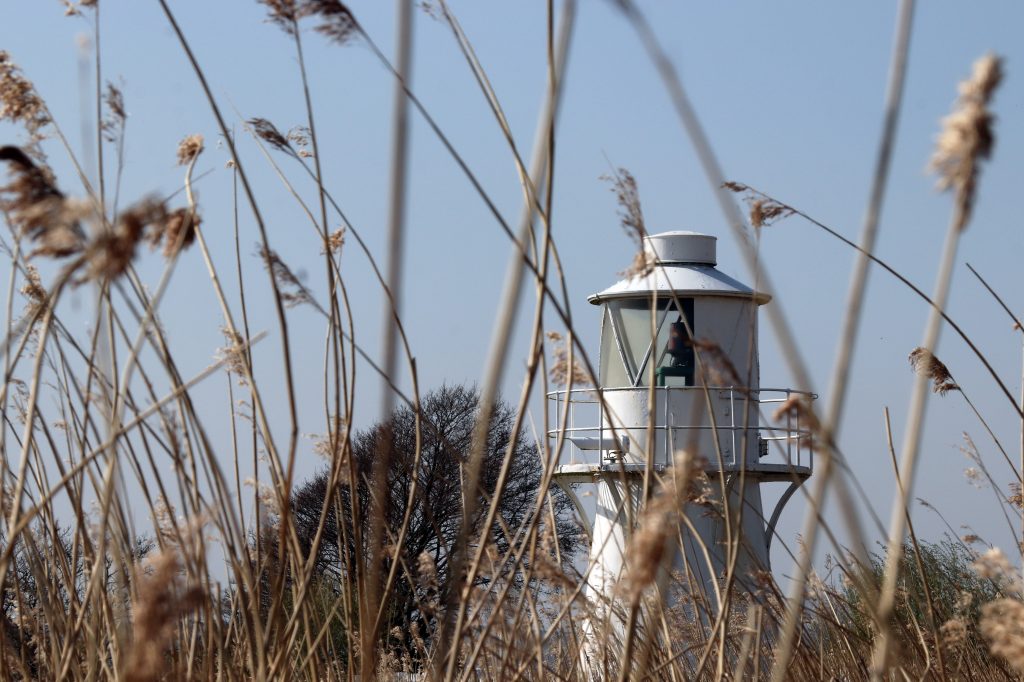
East Usk Lighthouse
Introduction
Only a month ago, there were major celebrations to mark the twenty-fifth anniversary of the construction of the RSPB Newport Wetlands Reserve. Created from heaps of polluted ash from the nearby Uskmouth Power Station, this conservation site was part mitigation for the loss of intertidal habitats caused by the creation of the Cardiff Bay barrage. Amazingly enough, the National Nature Reserve is now frequently viewed as the ‘jewel in the crown’ of the Gwent Levels and is famous for its shrill carder bees and its booming bitterns, amongst many other species.
Keen to put my recently acquired knowledge from a RSPB winter wader ID course to the test, and with ‘great expectations,’ I headed out with Geoff, my husband, to the reserve at the western end of the Caldicot Levels. We planned to explore some of the reserve as well as the coast around Goldcliff, famous for its historical and archaeological significance as well as its nature conservation value. And, once again, I’m delighted to be able share some comments from a local person with in-depth knowledge of and enthusiasm for the area in my article. Mike Pointon is a keen amateur naturalist with a particular interest in birds, who founded the Friends of Goldcliff Lagoons back in 2014. He’s not only worked alongside others to improve facilities for birdwatchers but also leads walks and has carried out monthly WeBS and hightide counts at the lagoons.

Extensive intertidal marshes, east of the Usk
The Reserve
As we planned the details of our walk in the coffee shop in the Visitor Centre at the start, the first avian challenge momentarily appeared – a distant dark speck flitted amongst the reeds at the far end of the pond. The elusive creature darted between the reeds, testing the limits of my DSLR camera’s zoom lens and a rather basic pair of binoculars we’d bought. The bird appeared quite small and possibly fluffy. Perhaps it was a baby bird? It was on its own, though, and it certainly didn’t resemble any of the species I’d seen on my bird ID course. Eventually, it swam closer. It continued to scurry nervously from one clump of reeds to another, teasing its small audience of onlookers inside the cafe. Eventually, it posed for a short while in front of us, giving me just enough time to capture a quick photo. Then as quickly as it had emerged, it disappeared into the reeds at the far end of the pond, having completed its morning performance. It was a little grebe. Well, I think it was. Certainly, so much smaller and fluffier than the great crested grebe which I’d recently seen gracing the waters of the Lisvane Reservoir in NE Cardiff. Wow! If that was the overture, what was the main performance going to be like?
We eagerly ventured along the waymarked paths into the reserve to do a hybrid walk, encompassing part of the ‘Wetlands Experience’ and the ‘Estuary Trail’ so we’d also be able to see Goldcliff as well on our short visit.
As we walked towards the shore in the reserve, we were surrounded by a sea of golden reeds, wafting gently in the breeze. Ribbons of vibrant green new growth edged the long unnaturally straight water areas which gleamed bright blue in the sun. Apart from a squishing sound as we walked across a floating pontoon amidst the reeds, it was relatively calm and peaceful. Perhaps a little too calm and peaceful? We stopped at various lookout posts where information boards tantalisingly displayed a range of possible birds we could encounter. No birds in sight today though. Hmmm. Overhead the towering pylons and power cables dominated the skyline and were reminders of the adjacent industrial site and the area’s continuing importance for power generation. Still no birds. The forbidding industrial backdrop, the scene for several episodes of Doctor Who loomed large behind the haven of the reserve. Still, no birds….
Then, just as we were about to move on, a few large birds swooped down and landed on the water in front of us. Certainly not a flock, but at least a handful of birds. And … they were easily recognisable! Canada geese! May be a grade one entry though, given their prevalence across our shores. However, as I found out later, they’re not a native bird, having been introduced from North America some 300 years ago. After some rather amorous advances between a couple of these geese, all too brief for my camera skills, I was able to capture some shots of these elegant birds, including the one here.
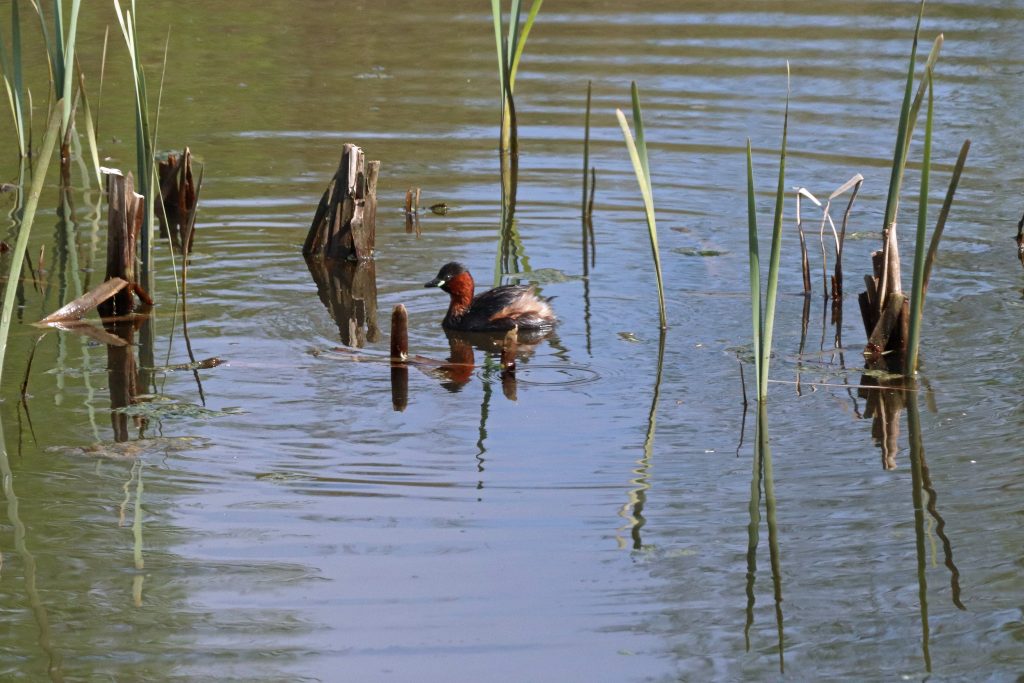
A little grebe entertains the café clientele
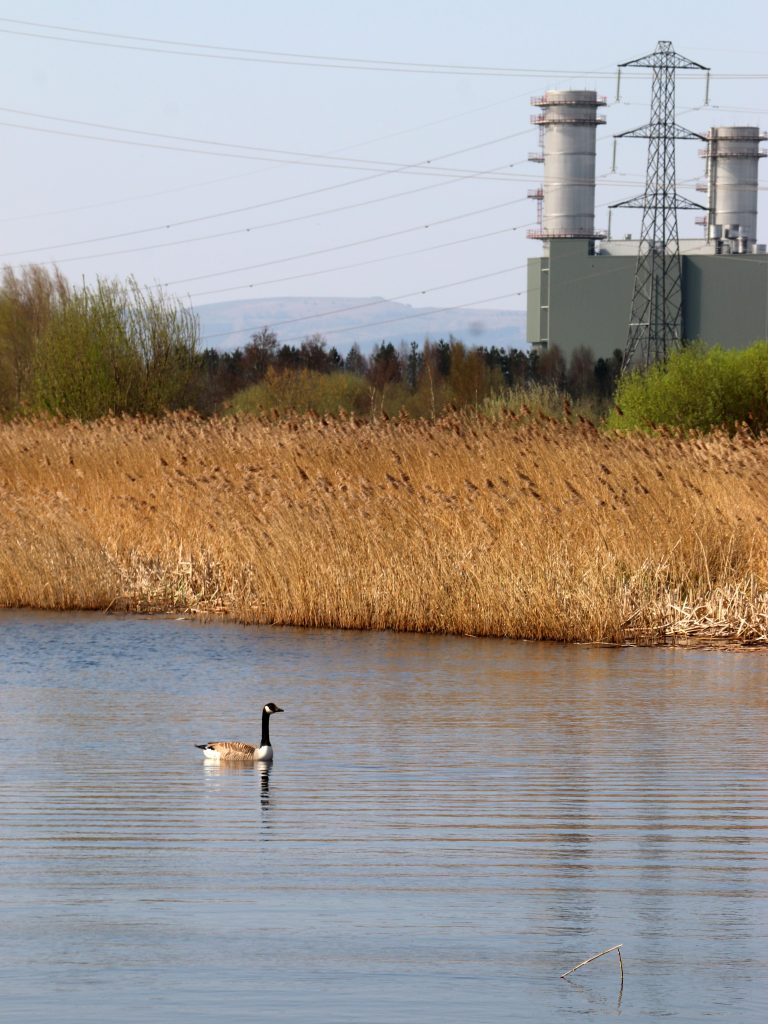
Canada goose on the reserve
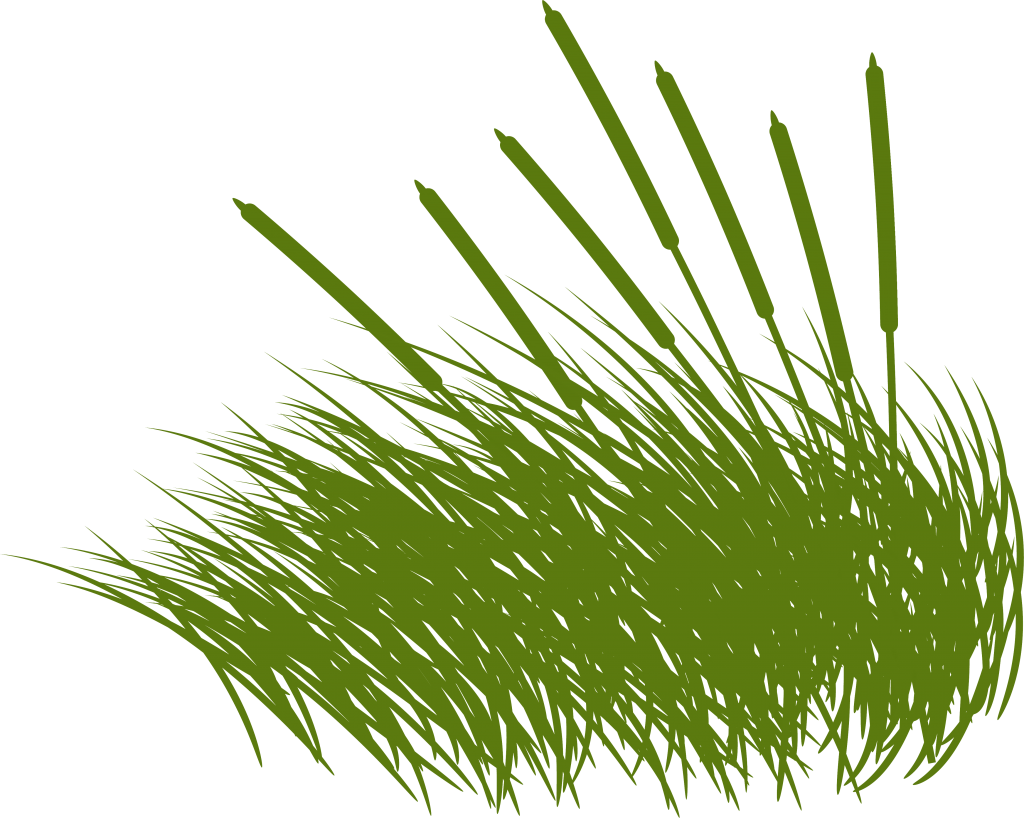
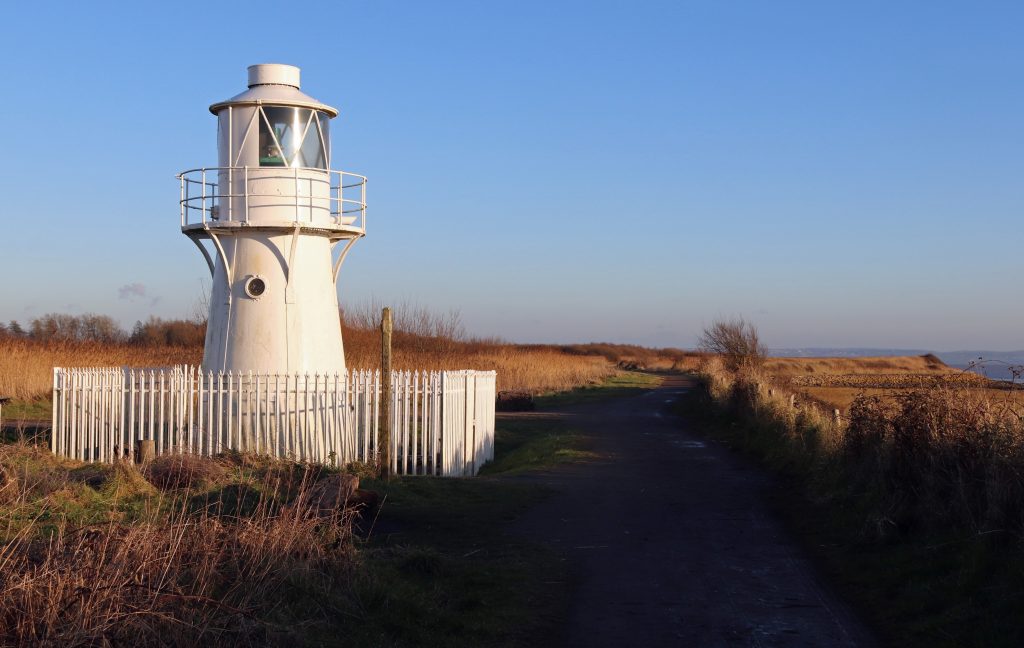
East Usk Lighthouse
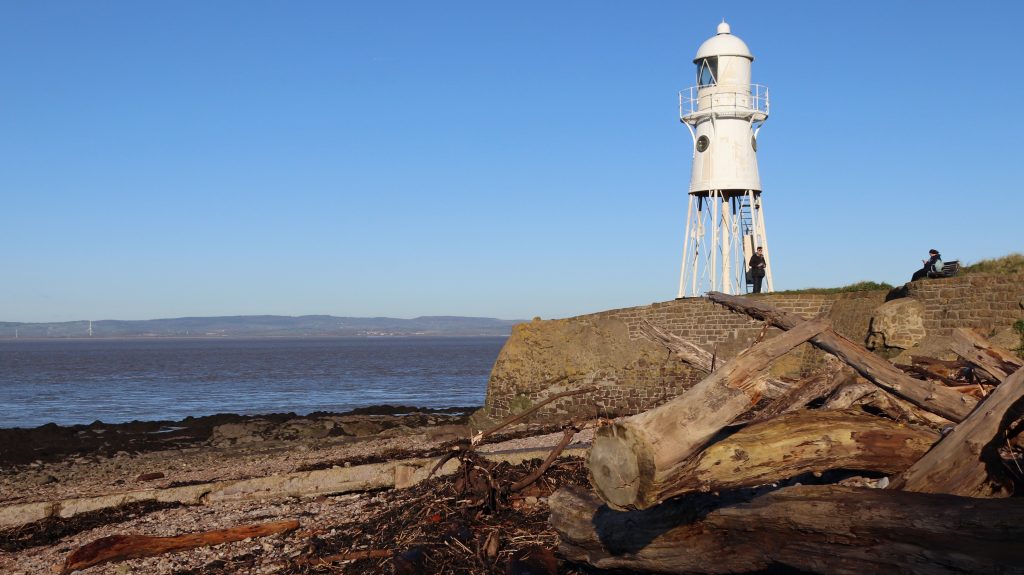
Blacknore lighthouse at Portishead
Walking further towards the shore, the lighthouse beckoned. However many times I’ve been to the reserve, I always seem to find myself clicking away, trying to capture a new camera angle and avoid that iconic, some might say, rather hackneyed, image of the lighthouse. Oh dear… yes, that’s my cover photo! On today’s visit, however, the ‘white cone on the water’s edge’ as Peter Finch describes it, was looking particularly fine in the golden light and seemed as popular as ever with the visitors. Glistening white, protected by its very own picket fence, this somewhat diminutive lighthouse looked more as if it belonged in a model village rather than being a working lighthouse. This is the East Usk Lighthouse though, and its light provides a vital navigation aid to ships approaching Newport. Indeed, its importance goes beyond that. It was the first Trinity House lighthouse to use a special valve, enabling the light to turn off and on remotely just using daylight. The most striking aspect to me though on our visit today, was the lighthouse’s resemblance to the Blacknore Lighthouse on the other side of the estuary at Portishead, where I’d visited only a couple of months ago. Back when the East Usk lighthouse was built in the late nineteenth century the structures would have been near-identical twins. Now, following tonnes of disposal of fly ash from the Usk Power Station which buried the legs of the East Usk lighthouse, they’re merely distant cousins!
From the raised embankment at the seaward edge of the reserve, the marshes stretch out as finger-like protrusions into the estuary’s mud. More bird-watching possibilities? Much to my excitement and relief, even with our limited apparatus, we could immediately distinguish the shelduck from the mallards. Fortunately, for us, they were heads down, enjoying the rich pickings of the newly exposed muds! However, even with their characteristic chestnut stripe and reddish bills, the shelducks are still quite well camouflaged against the russet browns and blue greys of the intertidal landscape. So are the curlews, but with their distinctive long, down-curved bills, we were just about able to pick out the odd one. Then, a few gulls flittered across the sky. They took a sudden turn and wheeled and glided onto the silver muds … unfortunately, just beyond the limits of our magnification. Well, at least our bird count had been reasonable. I’d also been reminded of my previous visit, when, thanks to the RSPB guide’s telescope, I’d seen scores of curlews and lapwings jam-packed at the water’s edge here as the tide was receding. Despite our show today and these memories, I was still a little envious of Mike’s memorable moments. These include doing early morning Bearded Tits surveys at Uskmouth and hearing ‘Reed and Sedge Warbler singing, perhaps even a Cuckoo calling and a Whitethroat and singing its rasping courtship song as it dances along the hedgerow’, all ‘whilst the mist rose above the reedbeds.’
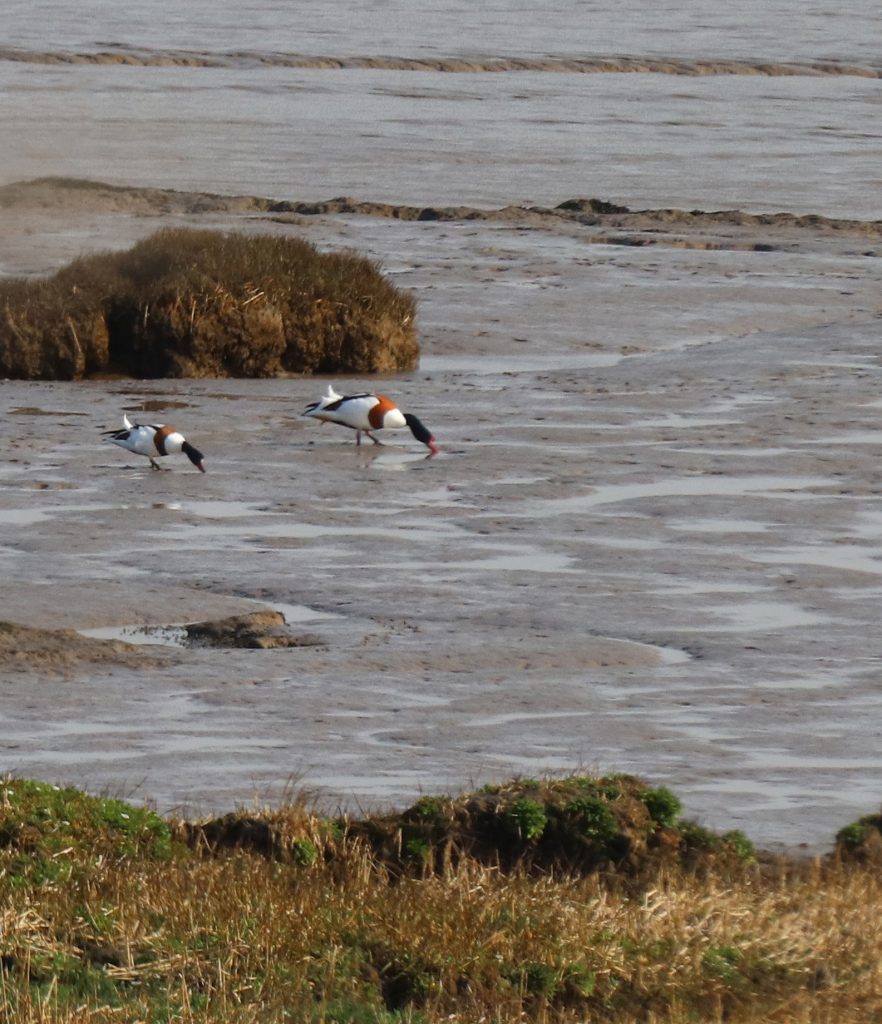
Shelducks feeding on the rich intertidal muds
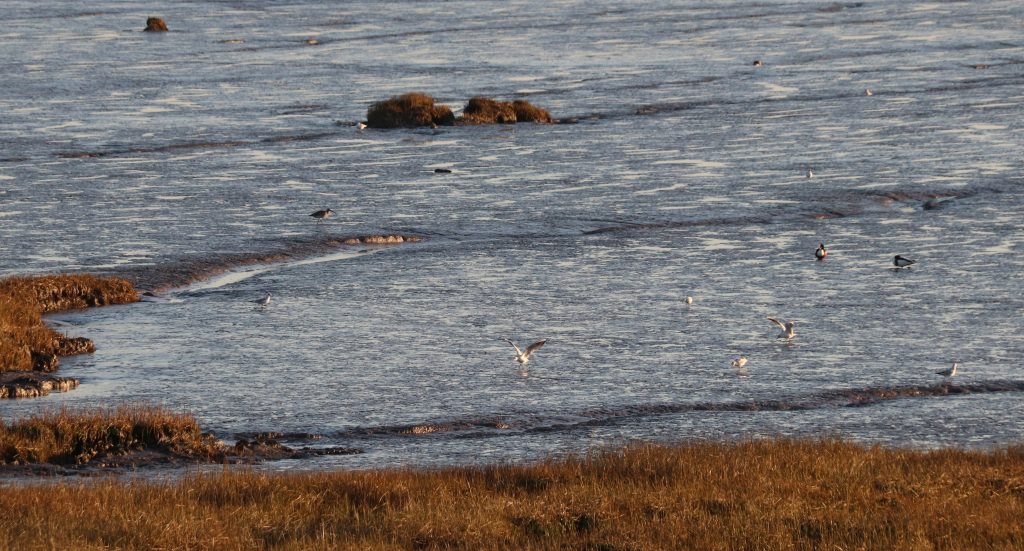
The white specks of coastal birds (gulls, shelducks and a curlew) on the silvery muds
Before we turned back to go on to Goldcliff, we strolled a little further along the coastal path, enjoying the ever-changing shoreline. The West Usk Lighthouse, which once marked the western entrance to the Usk river channel for ships heading to Newport docks, was just visible. Much more noticeable was the massive strandline. This coronet of gnarled driftwood encircled the entire coast, following the base of the embankment. The sheer scale of the mighty tree trunks engulfed in the debris were a stark reminder of the power of the winter storms which have plagued those inhabiting these shores over the millennia. Expecting to see today’s plague, plastic and other litter, I was very pleasantly surprised: there wasn’t any! I found out later that there’d been a litter pick by staff from Natural Resources Wales (NRW) and RSPB only a week or so before as part of Spring Clean Cymru when bags and of bags had been collected.
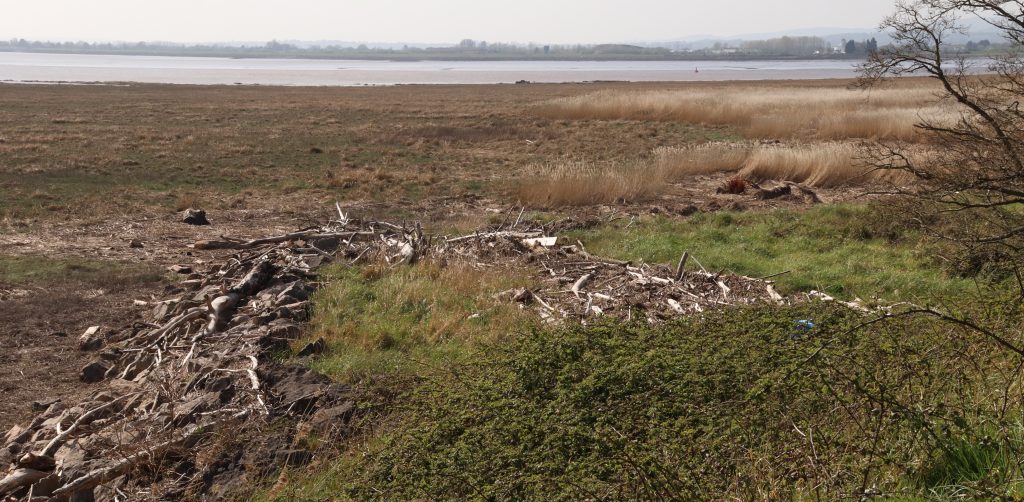
Looking towards the Usk a prominent strandline backs extensive intertidal marshes
The Goldcliff shoreline
We then wove our way along narrow lanes towards Goldcliff between a patch work of fields lined with deep and dark drainage ditches, a legacy of the Romans and the medieval monks who’d captured and tried to tame this watery landscape from the sea. No environmental impact studies in those days, just the need to provide valuable agricultural land to survive.
Then a small incline gradually came into view. This was the famous Goldcliff, a ‘rocky eminence’ which had caught the attention of the celebrated medieval cleric and celebrated travel writer, Gerald of Wales/Giraldus Cambrensis back in the twelfth century. In Gerald’s account, he’d noted that ‘when the sun’s rays strike it, the stone shines very bright and takes on a golden sheen’ and he’d even suggested that the ‘skilled’ might ‘dig down into the mineral deposits to extract sweet honey from the stone and oil from the rock.’ Centuries later, on our visit, there was no honey, oil nor indeed any gold. Only the rusting plinth of the old Goldcliff lighthouse provided a dash of colour, but even that looked in a sorry state, having lost its lantern in recent years. Not quite the magical place I’d hoped for. A substantive seawall skirts around the cliff and obscures seaviews. Any remains of the old Goldcliff Priory lie were also well hidden within ‘Hill Farm’, behind the sign reading ‘private property, keep out.’
Still, there was a great view from the cliff top and indeed also from the seawall which doubles up as the track of the Wales Coastal Path. Sites of previous walks, wind turbines, docks, piers and even the Prince of Wales Bridge were just discernible across the hazy estuary. Today, however, our attention centred around birds. There were a lot to see – gulls, mallards, shelduck and the odd curlew wading across the foreshore. Perhaps my bird ID was improving after all. Then in flew a flock of seabirds. They swirled and swooped in unison high above our heads before plummeting down to momentarily settle on the distant mudflats. They took to the air again. As the flock twisted and turned, shafts of sunlight caught their plumage. Constellations of seabirds lit up the sky. What a performance and all so amazingly choreographed. I’m just sorry I couldn’t capture any of it on camera or indeed identify the birds themselves.
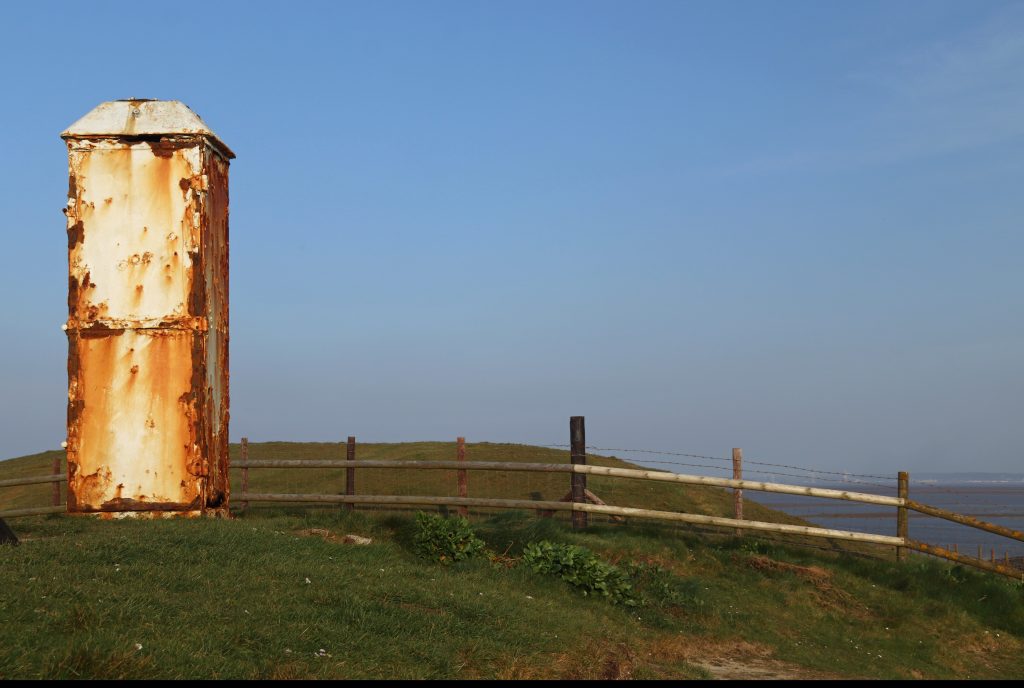
The only ‘gold’ at Goldcliff – the rusting lighthouse plinth perched on the top of the cliff
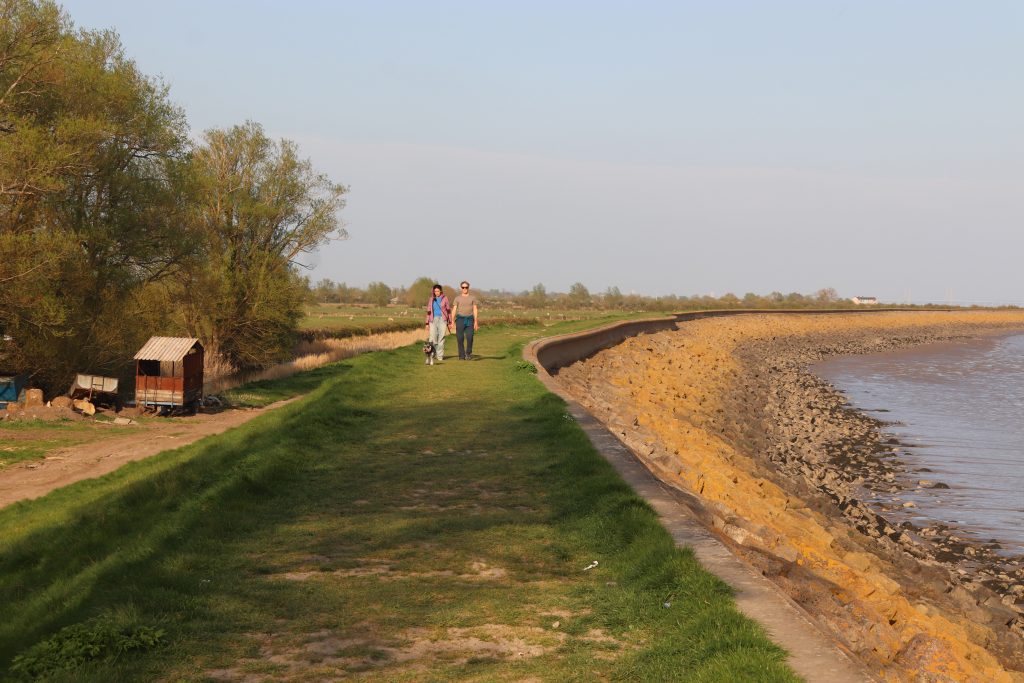
The seawall at Goldcliff

As the sun began to sink lower in the sky, a spider’s web of rivulets and channels appeared across the silvery muds and serried ranks of ancient timber poles cast long, dark shadows across the foreshore. The metamorphosis continued until the seascape resembled a scene from a John Piper lithograph, though sadly I don’t think he ever captured this stretch of Welsh coast. This was most certainly the ‘subtle landscape of land and water, a landscape sculpted by hand and time’ as described by Richard Urbanski in his account Walking the Gwent Levels. In the past, a clear calm early April day would have been an ideal time to check over the wooden frames, the putcher ranks, just prior to the start of the summer salmon fishing season. By late April there’d have been hundreds of putchers, willow baskets, full of fish which had been trapped by the previous tide. Last century the fishery declined though and finally ceased in the 1990s, marking the end of millennia of fish- trapping on the estuary. Indeed, those traps we were looking down on are thought to be of medieval origin, at a time when Goldcliff Priory was at its prime. However, the remains of considerably older fish traps (4000 BC) as well as footprints of Mesolithic age have also been discovered in the muds here and elsewhere on the estuary. How many more secrets of the tide might lie out there waiting to be discovered?
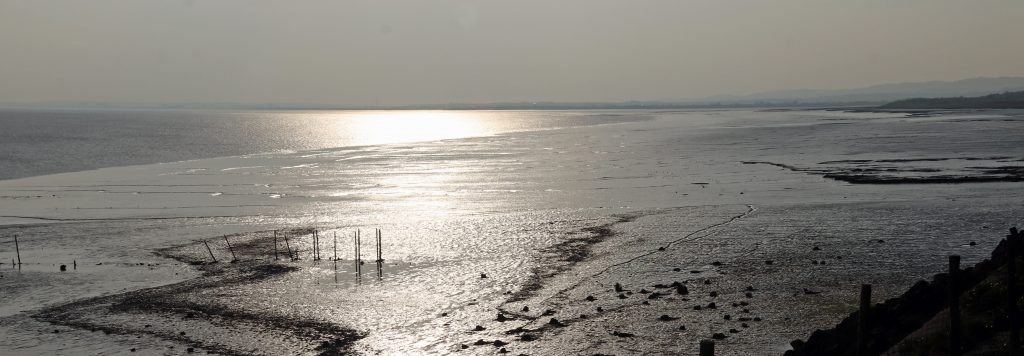
The silver shore from Goldcliff
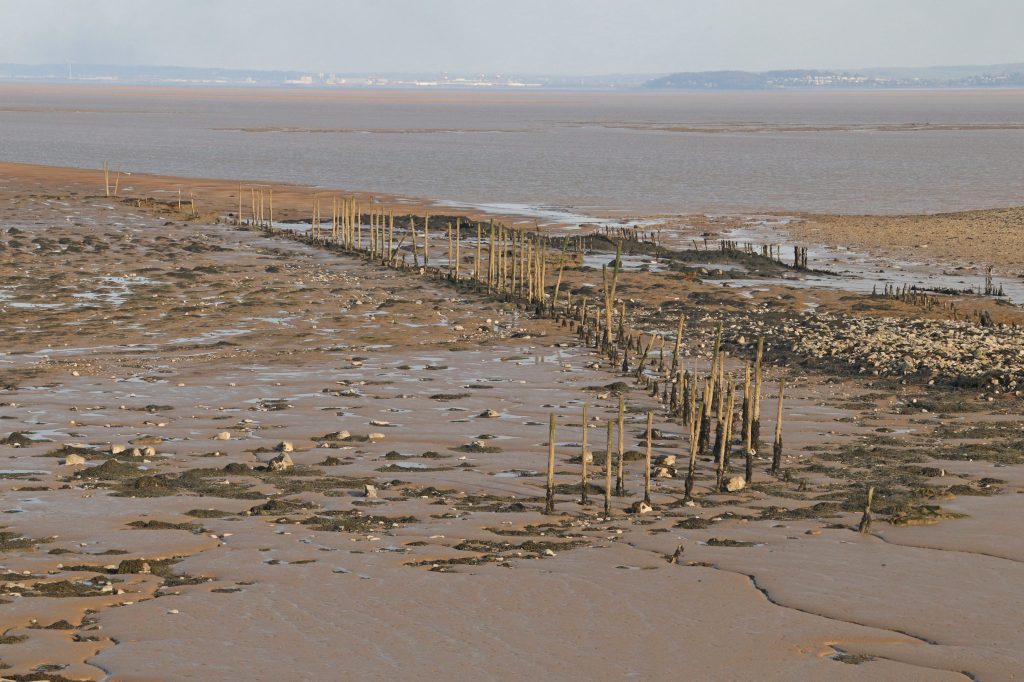
Ancient putcher frame stretching across the foreshore at Goldcliff
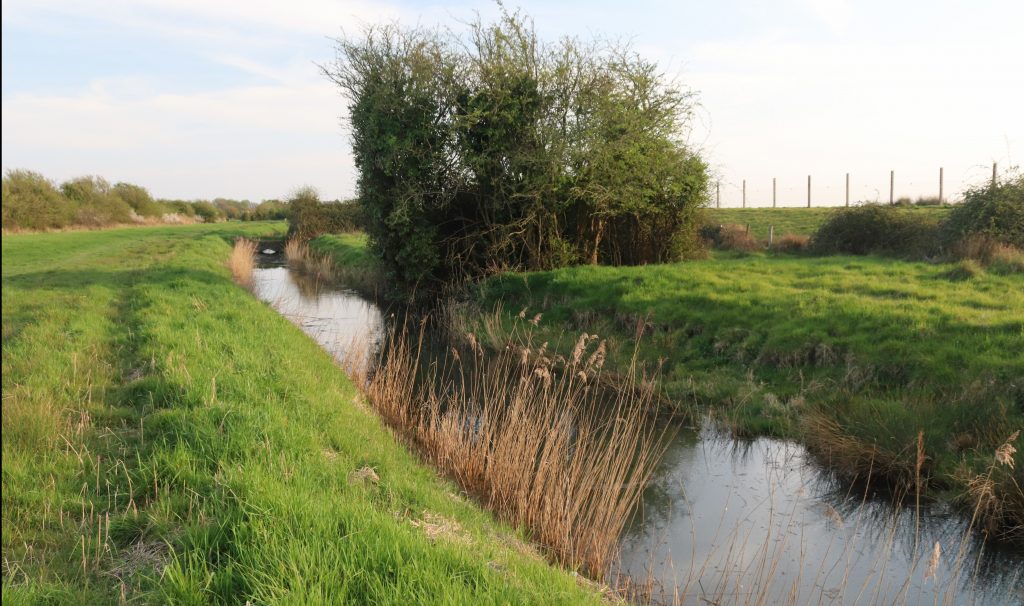
Mireland Pill Reen, one of many large drainage ditches across the Levels
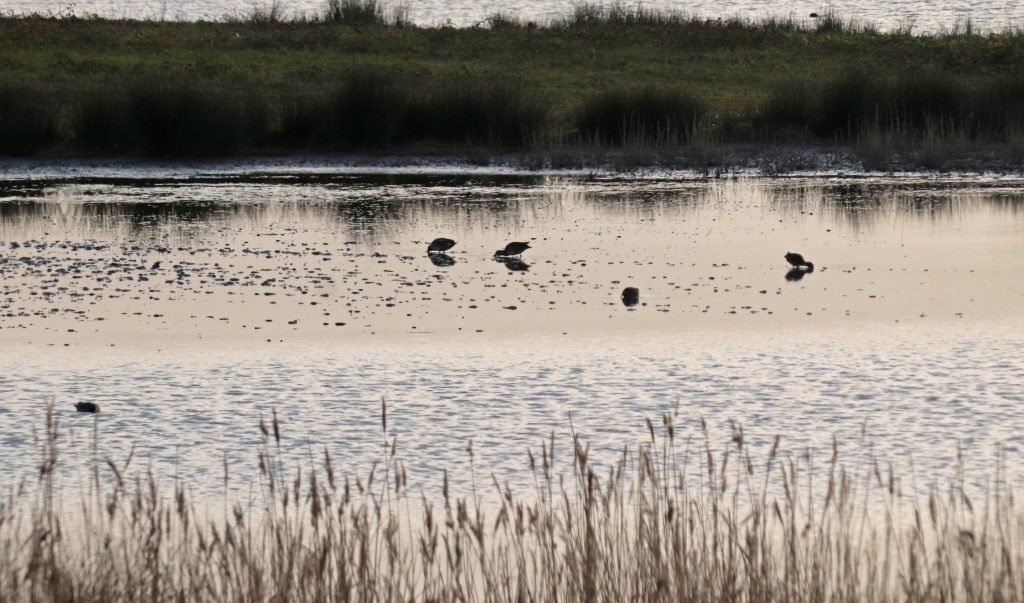
View from Hide 1 into the Monks Lagoon, Goldcliff
The Goldcliff Saline Lagoons
On to the famous Goldcliff Lagoons, a birder’s dream and one of Mike’s favourite birding locations. Mike particularly savours his ‘memories of watching the courtship displays of the waders here’ as well as ‘witnessing the birds on migration in autumn’. A birders’ website had previously informed me that its ‘almost always packed with waterfowl and waders throughout the year’ and provides a list of ‘nice birds that can be seen’ including the Little Grebe, Avocet, Dunlin and Little Egret. However, by now, with the rapidly fading light and our limited previous successes earlier in the day, my expectations were modest at best. We scuttled along the path by the Mireland Pill Reen, an impressive reminder of the ‘hand-crafted’ landscape of the Gwent Levels to reach the saline lagoons. Today, sadly, we’d no time to contemplate the wonders of this historic landscape and the feats of generations of engineers who’d claimed and reclaimed these precious agricultural pastures from marine inundation.
Our last stop merely consisted of a short foray into the very spacious and well-constructed hide. Hide 1, The Curlew Hide, overlooks the Monks Lagoon. Given the low light and the considerable distance between us and the birds, it really was bird spotting – the birds, mere spots, were hardly distinguishable against the darkening background. A frustrating wire fence also impaired our view and taking photographs. However, as we were just about able to pick out some waders with long curved bills …may be curlews? Lots and lots of them … but far too far away to photograph. There were also a few other types of waders tucking into the lagoon’s all-you-can-eat buffet, and so I clicked away and hoped at least one photo would be useable! Hopefully, now we’ve found this place, we’ll go back there with more time to spare and better equipment.
Final thoughts
I’d arrived at the wetlands with great expectations. although I’d neither seen nor heard any of the site’s most iconic species, I’ve certainly grown to appreciate the lure of this special place. Perched on the estuary’s edge, sandwiched between space-age industrial and traditional agricultural landscapes, it’s an unlikely place for such a success story. The original vision in establishing the original site has been more than realised. Thanks to massive engineering works, the installation of a sophisticated drainage system, and years of habitat management (overseen by Natural Resources Wales in partnership with RSPB Cymru and Newport City Council), mounds of pulverised fuel ash have been transformed into a rich mosaic of wetland and other habitats. These now support a wealth of plant, invertebrate and bird species as well as weasels, stoats and otters. There are so many groundbreaking achievements to celebrate – wading avocets, elusive bitterns and rare marsh harriers have all bred here for the first time in many years. Indeed, the reserve’s importance was confirmed through its SSSI and National Nature Reserve (NNR) nature conservation status within the last couple of decades. There are challenges, however, even here, as Mike is keen to point out. He, like many of the other birders, would like to see the area treated ‘in a more nature friendly way’ with dogs banned on the reserve. He’s also concerned about the possibility of ‘tidal power wind turbines disrupting the peace and tranquillity.’ There will always be differing ideas about the future of such precious sites, but I’m pleased to note the extensive attempts to bring the local community’s views into the fore, particularly through the Living Levels programme. Also, the achievements which have been accomplished here would not have happened without the help of armies of dedicated volunteers like Mike, who’ve given up so much time and effort to maintain and improve the site. I’m certainly starting to realise the importance of these volunteers – often unsung heroes at so many sites around the estuary.
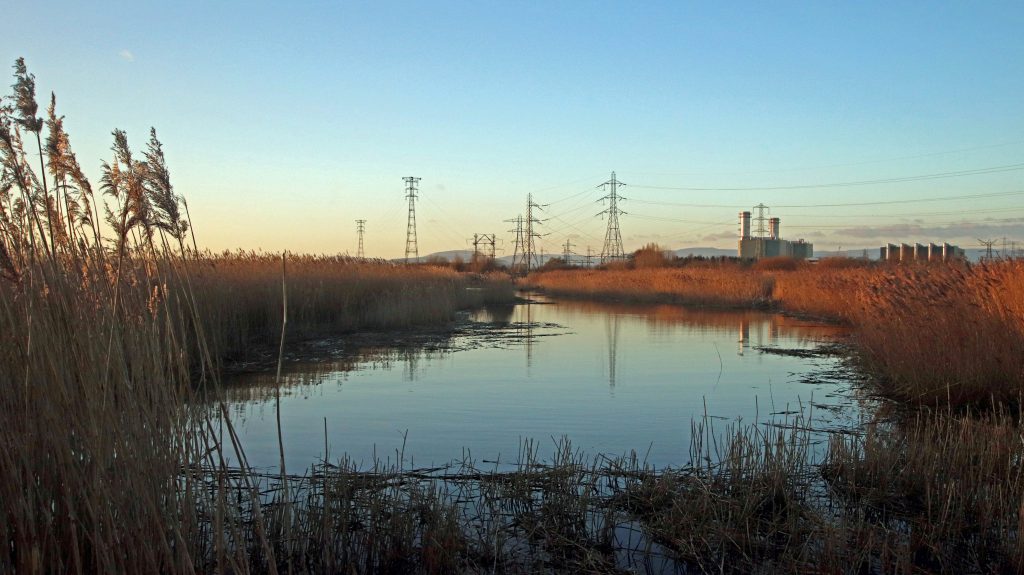
Evening light across the RSPB Newport Wetlands reserve
Apart from the nature recovery achievements at the site, I’m particularly taken by the accessibility of so much of the wetlands here to the public, although Mike warns of the dangers of treating ‘nature reserves as playgrounds for us humans.’ Young parents with pushchairs, older folks with their packed lunches and binoculars, keen birdwatchers with their giant lenses and others are all there. All sharing and enjoying their bit of ‘wildlife.’ There are lots of special events too to introduce you to the wonders of nature here. Even as I’m writing, there’s a weekend of fun activities ongoing as part of the City Nature Challenge. I agree with Mike that we should value such ‘places for quiet contemplation’ but it’s also important that people can experience, wonder and learn from these sites. Indeed, I hope to go down there myself sometime soon again to attend another workshop. However, this site is only part of the story – there’s much more to explore along the Gwent Levels as the Living Levels’ website informs me. Maybe not for my next walk, but certainly I’ll come back to this extraordinary land/seascape soon.
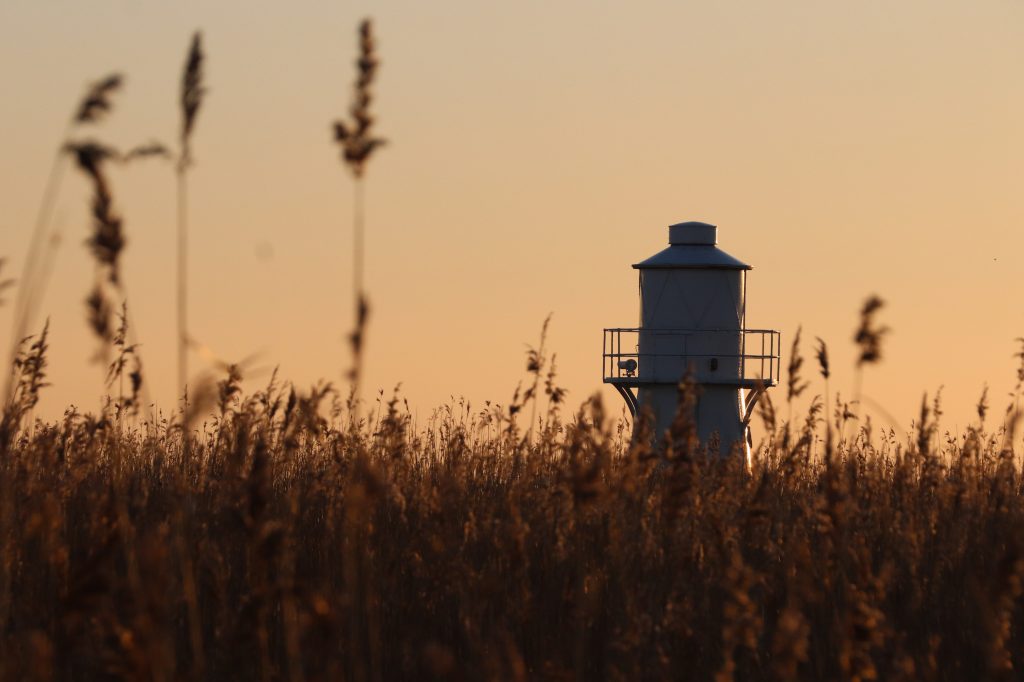
East Usk lighthouse in the evening light
A few websites of interest
Living Levels / Lefelau Byw website
The Newport Wetland and Goldcliff Loop walk
The Gwent Levels – taken the Historic Landscapes Register
 Severn Estuary Partnership
Severn Estuary Partnership